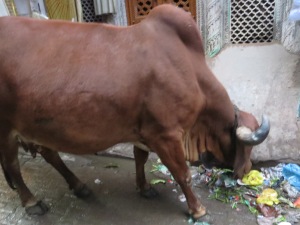We slept in, sort of, with our plan to meet the guide at 6:45 am to head back to the Ganges for a boat ride and walk through the old city. It was foggy and chilly, but such a relief after the hot hotel room. Compared to the night before the streets were empty, tea shops open, a bit of activity, but almost tranquil. It was fully light, but the river was misty as we glided away from the shore. The many cremations from the night before had dwindled to one, and large piles of ashes sat on the bank. After a cremation workers, not the family, take the ashes out into the river.
We passed some folks bathing, monkeys running along rooftops, dogs barking or wandering, and clothes washers, all young men, standing thigh deep in the cold water, facing the shore and slapping articles of clothing hard on flat rocks, sounding like shots echoing off the ghat.
We saw men tying a small, white-shrouded body onto a board with several bands of rough brown rope-we did not, of course, take a photo. (Children under the age of 8 are not cremated, but rather sunk in the middle of the river weighted by stones.)
We put ashore at the larger cremation site, and walked up through enormous stacks of logs, with more being added in preparation for that day. Our guide led us up the steps and into a dark, wet, claustrophobic alleyway perhaps 5 or 6 feet wide. On either side buildings of several stories, a mishmash of houses, huts, many shrines–some just cubbyholes–gates, and every ten yards or so an open fire where one or two people were huddled, or, in one case a fire in a stone box maybe a foot square, around which four puppies slept on their sides, bellies toward the warmth. We were surprised to see a very large, dark brown horned bull come ambling toward us as our guide told us to quickly stand aside. There was just enough room for him to pass without brushing against us. He stopped, snorted, and put his head down to look for something edible in a small, muddy pile of trash and leaves.
Our guide stopped at one tiny store where various wooden figures and other trinkets were for sale, and we bought a small box of six Ganeshes, each doing something different–playing an instrument, dancing, etc. We came upon a spice and tea shop, where our guide had us enter and sit down. The shop had glass cabinets up the walls full of spices and oils, and all kinds of tea. The entire enterprise was about ten feet deep and maybe four feet wide. He ordered chai for us which we welcomed as the morning was still quite chilly. We were served the most delicious, hot, rich, milky sweet chai in little clay cups–it went down so easily that we asked for a second. While we drank one of the shop fellows pitched aromatic oils for various uses, and we bought an assortment including a cure for sleeplessness (lotus flower). From this shop another guide took us to see the outside of the Golden Temple, down an even narrower walkway with very highs security–since only Hindus are allowed in we could only peek, trying to stay out of the way of a stream of Hindus all barefooted in the cold, wet morning, heading to prayers. We returned to the shop, met up with our guide again, and went back through the town to find our driver.
We went back to the hotel for breakfast and then got in the car to visit Sarnath. The trip there was short but harrowing…rush hour in full swing, and streets in abominable condition, and still very muddy from several days of rain. After 30 minutes or so we were there. First stop was the museum, small and largely dedicated to the Buddha, but also containing the original carving which is the symbol of India. During our visit the electricity went out for a few minutes, leaving the museum in total darkness, but no one seemed at all bothered, nor is this unusual for Sarnath. Then we walked across the street, dodging hawkers, and entered the lovely and very peaceful ruins. There were many tourists from Thailand, Sri Lanka, China. We passed monks chanting and enjoyed what appeared to be a very tight knit family of dogs, all the same size and colors, led by mom (our guess) and who were playing tag among the ruins, staring off in the distance all in the same direction–they were like a little army in charge of the place.


This is the place where the Buddha gave his first sermon, the spot marked by a huge stupa, a solid brick elongated mound sort of thimble shaped. In a nearby spot it is believed relics (maybe a small bone or two) were found in a jade box by a local king who threw them into the Ganges. He did not know whose they were, but this would have been the natural thing to do with cremains.
The park is both peaceful and clean and we enjoyed our wander. Next door is a Buddhist temple decorated with murals done by a Japanese artist showing the life of the Buddha. Many tourists/pilgrims were here from other Asian countries. Adjoining the temple is the grandson of the tree under which the Buddha first achieved enlightenment. On both sides of the shrine are a line of prayer wheels, Tibetan style, and there were several groups of pilgrims, some of whom asked our guide what were those things, while others walked along spinning each wheel in turn. Such are the varied ways in which Buddhism is observed.
Back at the hotel we collapsed in our room. Next day, Khajuraho!


















